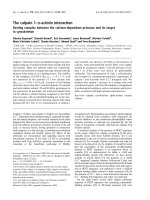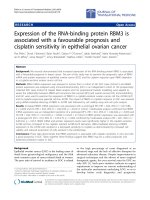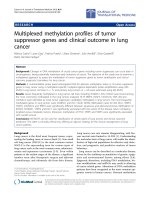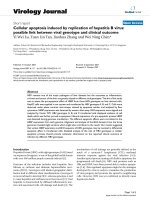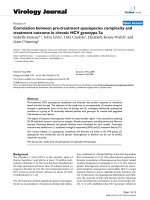Association between tumour infiltrating lymphocytes, histotype and clinical outcome in epithelial ovarian cancer
Bạn đang xem bản rút gọn của tài liệu. Xem và tải ngay bản đầy đủ của tài liệu tại đây (706.07 KB, 7 trang )
James et al. BMC Cancer (2017) 17:657
DOI 10.1186/s12885-017-3585-x
RESEARCH ARTICLE
Open Access
Association between tumour infiltrating
lymphocytes, histotype and clinical
outcome in epithelial ovarian cancer
Fiona R. James1,3* , Mercedes Jiminez-Linan2, Jennifer Alsop3, Marie Mack3, Honglin Song3, James D. Brenton3,
Paul D. P. Pharoah4 and H. Raza Ali5
Abstract
Background: There is evidence that some ovarian tumours evoke an immune response, which can be assessed by
tumour infiltrating lymphocytes (TILs). To facilitate adoption of TILs as a clinical biomarker, a standardised method
for their H&E visual evaluation has been validated in breast cancer.
Methods: We sought to investigate the prognostic significance of TILs in a study of 953 invasive epithelial ovarian
cancer tumour samples, both primary and metastatic, from 707 patients from the prospective population-based
SEARCH study. TILs were analysed using a standardised method based on H&E staining producing a percentage
score for stromal and intratumoral compartments. We used Cox regression to estimate hazard ratios of the
association between TILs and survival.
Results: The extent of stromal and intra-tumoral TILs were correlated in the primary tumours (n = 679, Spearman’s
rank correlation = 0.60, P < 0.001) with a similar correlation in secondary tumours (n = 224, Spearman’s rank
correlation = 0.62, P < 0.001). There was a weak correlation between stromal TIL levels in primary and secondary tumour
samples (Spearman’s rank correlation = 0.29, P < 0.001) and intra-tumoral TIL levels in primary and secondary tumour
samples (Spearman’s rank correlation = 0.19, P = 0.0094). The extent of stromal TILs differed between histotypes (Pearson
chi2 (12d.f.) 54.1, P < 0.0001) with higher levels of stromal infiltration in the high-grade serous and endometriod cases. A
significant association was observed for higher intratumoral TIL levels and a favourable prognosis (HR 0.74
95% CI 0.55–1.00 p = 0.047).
Conclusion: This study is the largest collection of epithelial ovarian tumour samples evaluated for TILs. We have shown
that stromal and intratumoral TIL levels are correlated and that their levels correlate with clinical variables such as tumour
histological subtype. We have also shown that increased levels of both intratumoral and stromal TILs are associated with
a better prognosis; however, this is only statistically significant for intratumoral TILs. This study suggests that a clinically
useful immune prognostic indicator in epithelial ovarian cancer could be developed using this technique.
Keywords: Tumour infiltrating lymphocytes (TILs), Epithelial ovarian cancer, Standardised method, Histological subtype,
Survival time
* Correspondence:
1
Lancashire Teaching Hospitals Foundation NHS Trust, Lancashire, UK
3
Department of Oncology, University of Cambridge, Cambridge, UK
Full list of author information is available at the end of the article
© The Author(s). 2017 Open Access This article is distributed under the terms of the Creative Commons Attribution 4.0
International License ( which permits unrestricted use, distribution, and
reproduction in any medium, provided you give appropriate credit to the original author(s) and the source, provide a link to
the Creative Commons license, and indicate if changes were made. The Creative Commons Public Domain Dedication waiver
( applies to the data made available in this article, unless otherwise stated.
Background
Methods
Study
Immunohistochemistry
and flow cytometric analysis
Immunohistochemistry
Immunohistochemistry
Immunohistochemistry
Immunohistochemistry
Immunohistochemistry
Immunohistochemistry
Immunohistochemistry
Immunohistochemistry
Paper
Woo, E.Y. et al., 2001 [4]
Zhang et al., 2003 [5]
Curiel, T.J., et al., 2004 [6]
Sato, E., et al., 2005 [7]
Hamanishi, J., et al., 2007 [8]
Tomsova et al., 2007
Shah, C.A., et al., 2008 [10]
Adams, S.F., et al., 2009 [11]
Clarke, B., et al., 2009 [12]
500
134
119
116
70
117
104
186
9
Sample size
CD8(+) T cells
CD3(+) T cells
CD3(+) T cells
CD8(+) T cells
FoxP3(+) Tregs
CD3(+) T cells
CD8(+) T cells
CD68(+) TAMs
FoxP3(+) Tregs
CD3(+) T cells
PD-L1 expression on tumour
cells
CD8(+) T cells
CD8(+) T cells
CD3(+) T cells
CD8(+)/CD4(+) T cell ratio
CD4(+)CD25(+)FOXP3(+)
T(reg) cells
CD3(+) T cells
CD4(+)CD25(+) T cells
CD8(+)CD25(+) T cells
Type of immune infiltrate
Increased CD8(+) T cells is associated with
increased survival
Increased CD3(+) T cells is not associated
with any difference in survival
On subgroup analysis: For serous ovarian
carcinomas, increased CD3(+) and CD8(+)
T-cells correlated with improved survival
For endometrioid and clear cell carcinomas
Increased CD8(+) T cells is associated with
increased survival
No difference in survival associated with
the other cell types
TIL and TAM levels are positively correlated
Patients with greater TILs are more likely to
be optimally cytoreduced
The presence of circulating tumor DNA does
not correlate with TILs, TAMs, or Tregs
No association between any cell type and
survival seen
CD3(+) TILs are associated with increased survival
Increased PD-L1 expression on tumour cells
is associated with decreased CD8(+) T cells
and decreased survival
Increased CD8(+) t cells is independently
associated with increased survival
Increased CD8+ T cells is associated with
increased survival
No association between CD3+ TILs and survival
Increased CD8(+):CD4(+) associated with
better survival
T(reg) cells suppress tumor-specific T cell
immunity and contribute to growth of human
tumors in vivo.
T(reg) cells are associated with a high death
hazard and reduced survival
The presence of intratumoral T cells correlated
with delayed recurrence and an increased
expression of IFN γ, IL-2, within the tumor.
The absence of intratumoral T cells was
associated with increased levels of VEGF.
Increased % of CD4(+)CD25(+) T cells present
in ovarian cancer.
CD8(+) T cells expressed low levels of CD25
Conclusion
Table 1 Studies investigating immune cell response and effect on prognosis in epithelial ovarian cancer
Effect on prognosis
Increased CD8(+) T cells is associated
with increased survival
Increased CD3(+) T cells is not associated
with any difference in survival
Increased CD8(+) T cells is associated
with increased survival
No difference in survival associated
with the other cell types
No association between any cell type
and survival seen
Increased CD3(+) T cells is associated
with increased survival
Increased CD8(+) t cells is associated
with increased survival
Increased CD8+ T cells is associated
with increased survival
No association between CD3+ TILs
and survival
Increased CD8(+):CD4(+) associated
with increased survival
T(reg) cells are associated with
reduced survival
Increased CD3(+) T cells is associated
with increased survival
Not discussed
James et al. BMC Cancer (2017) 17:657
Page 3 of 7
Immunohistochemistry
Immunohistochemistry
Immunohistochemistry
Immunohistochemistry
Immunohistochemistry
Immunohistochemistry
immunohistochemistry
Stumpf et al., 2009 [14]
Webb et al., 2014 [15]
Darb-Esfahani et al. 2016 [16]
Woulters et al. 2016 [17]
Bösmüller et al. 2016 [18]
Strickland et al. 2016 [19]
Kroeger et al. 2016 [20]
245
135
171
215
497
100
306
CD20+ Tcells
CD4+ Tcells
CD8+ T cells
Plasma cells
CD3+ T cells
CD8+ T cells
CD3 T cells
CD103 T cells
CD8(+) T cells
CD27(+) T cells
CD3+, PD-1+, and
PD-L1+ T cells
CD103(+) T cells
CD20(+) B cells
CD3(+) T cells
CD4(+) T cells
CD8(+) T cells
CD8(+) T cells
CD45RO(+) Tmems
FoxP3(+) Tregs
Table abbreviations: Tregs regulatory T cells, TAM tissue associated macrophages, Tmems memory T cells
Immunohistochemistry
Leffers et al., 2009 [13]
CD8(+) TIL carried prognostic benefit only
in the presence of PCs and these other
TIL subsets.
Increased CD3+ and CD8+ TILs associated
with increased survival
Both the presence of CD103 cells, as well as
high numbers of intraepithelial CD3 lymphocytes
(CD3E), showed a significant correlation with
overall survival
A prognostic benefit for patients with high
intratumoral CD8(+) TIL was observed if
primary surgery had resulted in a complete
cytoreduction, optimal or incomplete
cytoreduction fully abrogated the prognostic
effect of CD8(+) TIL. Neither CD8(+) nor CD27(+)
cell infiltration was of prognostic benefit in
patients treated with neoadjuvant chemotherapy.
CD3+, PD-1+, and PD-L1+ TILs densities were
correlated with increased survival Moreover,
high PD-1+ TILs as well as PD-L1+ TILs densities
added prognostic value to CD3 + TILs
CD103(+) TILs comprise intraepithelial, activated
CD8(+) T cells, and NK cells and are strongly
associated with patient survival in HGSC
CD3(+) T cells and CD8(+) T cells are associated
with increased survival
increased CD8(+) CTL and CD8(+)/FoxP3(+)
ratio is associated with increased survival
in advanced stage patients increased CD8(+)
T cells and FoxP3(+) Tregs is associated with
increased survival
there is no association between CD3(+) or
CD8(+) and survival
Table 1 Studies investigating immune cell response and effect on prognosis in epithelial ovarian cancer (Continued)
CD8(+) TIL carried prognostic benefit
only in the presence of PCs and these
other TIL subsets.
Increased CD3+ and CD8+ TILs
associated with increased survival
Both the presence of CD103 cells, as
well as high numbers of intraepithelial
CD3 lymphocytes (CD3E), showed a
significant correlation with overall
survival
CD8+ TILs interact with treatment to
affect prognosis
CD3+, PD-1+, and PD-L1+ TILs densities
were correlated with increased survival
in HGSC
CD103(+) TILs are strongly associated
with patient survival in HGSC
CD3(+) T cells and CD8(+) T cells
are associated with increased survival
increased CD8(+) CTL and CD8(+)/
FoxP3(+) ratio is associated with
increased survival
in advanced stage patients increased
CD8(+) T cells and FoxP3(+) Tregs is
associated with increased survival
James et al. BMC Cancer (2017) 17:657
Page 4 of 7
James et al. BMC Cancer (2017) 17:657
Page 5 of 7
Fig. 2 Number of patients by available tumour sample
There was a moderately strong correlation between
the extent of stromal and intra-tumoral TIL levels in the
primary tumour (n = 679, Spearman’s rank correlation = 0.60,
P < 0.001) with a similar correlation in secondary tumours
(n = 224, Spearman’s rank correlation = 0.62, P < 0.001).
Secondary tumour samples were either omental metastases
or metastases at other sites. We used the data for the omental metastases in preference to data for other metastases if
present; otherwise the data from the other metastases was
used. We also evaluated the correlation between TIL levels
in primary and metastatic tumours using data from the 196
women for whom both a primary and a secondary tumour
sample was available. There was a statistically significant but
weak correlation between stromal TIL levels in primary
and secondary tumour samples (Spearman’s rank correlation = 0.29, P < 0.001) and intra-tumoral TIL levels
in primary and secondary tumour samples (Spearman’s
rank correlation = 0.19, P = 0.0094) (Table 3).
Table 2 Clinical characteristics of ovarian cancer cases included
in this study
Histotype
Fig. 1 Representative examples of tumours with very low, low and
high TIL
Results
Data were available for 953 invasive epithelial ovarian
tumours (primary and/or metastatic), from 707 women.
Of these, primary tumour material was available for 682
cases, omental tumour material for 161 cases and other
metastasis material was available for 114 cases (Fig. 2).
The clinical characteristics (age at diagnosis and stage)
of these cases by histotype are shown in Table 2.
Mean age
at diagnosis
Stage
I/II (%a)
III/IV (%)
Unknown
Total
LGSC
54.0
5 (25)
15 (75)
3
23
HGSC
57.5
80 (29)
192 (71)
42
314
Mucinous
52.7
39 (91)
4 (9)
5
48
Endometrioid
54.5
113 (91)
11 (9)
11
135
Clear cell
55.7
70 (91)
7 (9)
5
82
Other
56.3
39 (64)
22 (36)
8
69
Borderline
49.6
33 (100)
0 (0)
3
36
Total
55.7
379 (60)
251 (40)
77
707
LGSC low-grade serous cancer, HGSC high-grade serous cancer
a
percent of those with known stage
James et al. BMC Cancer (2017) 17:657
Page 6 of 7
Table 3 Association between tumour infiltrating lymphocyte
levels in primary and secondary tumours for stromal and
intratumoral infiltrating lymphocytes
Primary tumour
infiltrating lymphocytes
Secondary tumour infiltrating lymphocytes
<5%
5–9%
≥10%
Total
21
25
39
85
Stromal
< 5%
5–9%
7
17
39
63
≥10%
4
8
37
49
Total
32
50
115
197
< 5%
96
55
19
170
5–9%
6
4
5
15
Intra-tumoral
≥10%
3
5
3
11
Total
105
64
27
196
The extent of stromal TIL levels differed between histotypes (Table 4, Pearson chi2 (12d.f.) 54.1, P < 0.0001) with
higher levels of stromal infiltration in the high-grade serous
and endometriod cases. However, there was little difference
in the degree of intra-tumoral infiltrating lymphocytes by
histotype (Pearson chi2 (12d.f.) = 15.0, P = 0.24).
We assessed the impact of tumour infiltrating lymphocytes on ovarian cancer specific mortality after diagnosis
using multi-variable Cox proportional hazards regression.
Table 4 Intra-tumoral and stromal tumour infiltrating lymphocyte
levels by histotype
Histotype
Tumour infiltrating lymphocyte level Number (%)
<5%
5–9%
≥10%
Total
13 (57)
8 (35)
2 (9)
23
Stromal
Low-grade serous
High-grade serous 122 (39)
85 (27)
107 (34)
314
Mucinous
12 (25)
8 (17)
48
28 (58)
Endometrioid
68 (50)
29 (22)
38 (28)
135
Clear cell
58 (71)
12 (15)
12 (14)
82
Other
33 (48)
18 (26)
18 (26)
69
Borderline
30 (83)
4 (11)
2 (6)
36
Total
352 (50)
168 (24)
187 (26)
707
20 (87)
Intra-tumoral
Low-grade serous
1 (4)
2 (9)
23
High-grade serous 240 (76)
47 (15)
27 (9)
314
Mucinous
43 (90)
3 (6)
2 (4)
48
Endometrioid
108 (80)
20 (15)
7 (5)
135
Clear cell
69 (84)
8 (10)
5 (6)
82
Other
58 (84)
8 (12)
3 (4)
69
Borderline
34 (94)
2 (6)
0 (0)
36
Total
572 (81)
89 (13)
46 (7)
707
The extent of tumour infiltrating lymphocytes in three
categories (<5%, 5–9%, ≥10%) was treated as an ordinal
variable in the model. An increase in stromal TIL levels
was associated with a slightly better prognosis but the difference was not statistically significant (HR 0.87 95% CI
0.74–1.02 p = 0.091). A slightly stronger and nominally
significant association was observed for intra-tumoral TIL
levels (hazard ratio = 0.74, P = 0.047). When the extent of
both stromal and intra-tumoral TIL levels were included
in a multi-variable model the effect of the intra-tumoral
TIL levels was similar (HR 0.76 95% CI 0.58–1.00
p = 0.047), but the association of the stromal lymphocytes
was attenuated (HR 0.97 95% CI 0.79–1.19 p = 0.78).
There was little evidence for heterogeneity of effect of
intra-tumoral TIL levels by histotype, although the effect
was strongest in the high-grade serous cases (HR 0.70
95% CI 0.50–0.97 p = 0.034).
Discussion
This study is the largest collection of epithelial ovarian
tumour samples evaluated for TILs, with almost double
the number of tumour samples as the largest published
study to date [12]. This is also the first time this standardised H&E visual assessment method of TIL evaluation
has been used in ovarian tumours.
We have shown that TILs as assessed by stromal
lymphocyte levels correlate with clinical variables such
as tumour histological subtype. However, intratumoral
TILs did not. We have also shown that increased levels
of both intratumoral and stromal TILs are associated
with a better prognosis; however, this is only statistically
significant for intratumoral TILs.
These results add weight to the argument that the immune system plays an important role in ovarian cancer.
They also support the idea that different subtypes of
ovarian cancer are variably immunogenic and that the
immune response can help define different subtypes.
The difference between stromal and intratumoral TIL
effects, despite their correlated levels in both primary
and secondary tumours, is interesting, and warrants
further investigation. The greater prognostic effect of
intratumoral TILs may explained by the biological rationale that T-cell activation necessitates physical contact with
target cells in order to engage the T cell receptor [26]. In
contrast, the lesser prognostic effect of stromal TILs
might be explained in two ways; either they are in-transit
to tumour cells hence will eventually become intratumoral
TILs, or that they have been ‘excluded’ from the tumour
microenvironment by factors secreted by tumour cells
and/or other stromal cells, as a means of evading immune
attack [26]. Further work to elucidate the distinct roles of
intratumoral and stromal TILs is needed.
The results suggest that a clinically useful immune
prognostic indicator in epithelial ovarian cancer could
James et al. BMC Cancer (2017) 17:657
be developed using this technique, but larger scale
studies are needed to replicate these results. Thus, further studies evaluating the potential of TILs as predictors of treatment response are warranted.
Conclusion
This study is the largest collection of epithelial ovarian
tumour samples evaluated for TILs. We have shown that
stromal and intratumoral TIL levels are correlated and
that their levels correlate with clinical variables such as
tumour histological subtype. We have also shown that
increased levels of both intratumoral and stromal TILs
are associated with a better prognosis; however, this is
only statistically significant for intratumoral TILs. This
study suggests that a clinically useful immune prognostic
indicator in epithelial ovarian cancer could be developed
using this technique.
Abbreviations
H&E: Hematoxylin and eosin; ITL: Intratumoral lymphocytes; SL: Stromal
lymphocytes; TILs: Tumour infiltrating lymphocytes
Acknowledgements
We thank all the patients who contributed to this study and the SEARCH
team for patient recruitment and the staff of the National Cancer
Registration Service East for providing access to patient clinical data.
Funding
This study was funded by Cancer Research UK (C490/A16561).
The funders of this project had no role in the design of the study and
collection, analysis, and interpretation of data and in writing the manuscript.
Availability of data and materials
The data presented in this manuscript are available at.
/>Authors’ contributions
Project conception and design: HRA, JDB and PDPP. Pathology review: HRA
and MJ-L. Processing of pathology material and generation of pathology
data: JA, HS and MM. Management of the SEARCH clinical database: HS. Data
analysis: FRJ and PDPP. Drafting of the manuscript: FRJ, HRA and PDPP. All
authors reviewed and approved the final version of the manuscript.
Ethics approval and consent to participate
SEARCH is approved by the Cambridgeshire 4 Research Ethics
Committee. All participants provided written informed consent.
Consent for publication
Not applicable.
Competing interests
The authors declare that they have no competing interests.
Publisher’s Note
Springer Nature remains neutral with regard to jurisdictional claims in
published maps and institutional affiliations.
Author details
1
Lancashire Teaching Hospitals Foundation NHS Trust, Lancashire, UK.
2
Department of Pathology, University of Cambridge, Cambridge, UK.
3
Department of Oncology, University of Cambridge, Cambridge, UK.
4
Department of Oncology, Department of Public Health and Primary Care,
University of Cambridge, Cambridge, UK. 5Department of Pathology, CRUK
Cambridge Institute, University of Cambridge, Cambridge, UK.
Page 7 of 7
Received: 5 March 2017 Accepted: 22 August 2017
References
1. Jemal A, et al. Global cancer statistics. CA Cancer J Clin. 2011;61(2):69–90.
2. Agarwal R, Kaye SB. Prognostic factors in ovarian cancer: how close are we
to a complete picture? Ann Oncol. 2005;16(1):4–6.
3. Kandalaft LE, et al. Immunotherapy for ovarian cancer: what's next? J Clin
Oncol. 2011;29(7):925–33.
4. Woo EY, et al. Regulatory CD4(+)CD25(+) T cells in tumors from patients
with early-stage non-small cell lung cancer and late-stage ovarian cancer.
Cancer Res. 2001;61(12):4766–72.
5. Zhang L, et al. Intratumoral T cells, recurrence, and survival in epithelial
ovarian cancer. N Engl J Med. 2003;348(3):203–13.
6. Curiel TJ, et al. Specific recruitment of regulatory T cells in ovarian carcinoma
fosters immune privilege and predicts reduced survival. Nat Med. 2004;10(9):942–9.
7. Sato E, et al. Intraepithelial CD8+ tumor-infiltrating lymphocytes and a high
CD8+/regulatory T cell ratio are associated with favorable prognosis in
ovarian cancer. Proc Natl Acad Sci U S A. 2005;102(51):18538–43.
8. Hamanishi J, et al. Programmed cell death 1 ligand 1 and tumor-infiltrating
CD8+ T lymphocytes are prognostic factors of human ovarian cancer. Proc
Natl Acad Sci U S A. 2007;104(9):3360–5.
9. Tomsova M, et al. Prognostic significance of CD3+ tumor-infiltrating
lymphocytes in ovarian carcinoma. Gynecol Oncol. 2008;108(2):415–20.
10. Shah CA, et al. Intratumoral T cells, tumor-associated macrophages, and
regulatory T cells: association with p53 mutations, circulating tumor DNA and
survival in women with ovarian cancer. Gynecol Oncol. 2008;109(2):215–9.
11. Adams SF, et al. Intraepithelial T cells and tumor proliferation: impact on the
benefit from surgical cytoreduction in advanced serous ovarian cancer. Cancer.
2009;115(13):2891–902.
12. Clarke B, et al. Intraepithelial T cells and prognosis in ovarian carcinoma:
novel associations with stage, tumor type, and BRCA1 loss. Mod Pathol.
2009;22(3):393–402.
13. Leffers N, et al. Prognostic significance of tumor-infiltrating T-lymphocytes
in primary and metastatic lesions of advanced stage ovarian cancer. Cancer
Immunol Immunother. 2009;58(3):449–59.
14. Stumpf M, et al. Intraepithelial CD8-positive T lymphocytes predict survival
for patients with serous stage III ovarian carcinomas: relevance of clonal
selection of T lymphocytes. Br J Cancer. 2009;101(9):1513–21.
15. Webb JR, et al. PD-L1 expression is associated with tumor-infiltrating T cells
and favorable prognosis in high-grade serous ovarian cancer. Gynecol
Oncol. 2016 May;141(2):293–302.
16. Darb-Esfahani S, et al. Prognostic impact of programmed cell death-1 (PD-1) and
PD-ligand 1 (PD-L1) expression in cancer cells and tumor-infiltrating lymphocytes
in ovarian high grade serous carcinoma. Oncotarget. 2016 Jan 12;7(2):1486–99.
17. Woulters MC, et al. Size matters: survival benefit conferred by intratumoral
T cells is dependent on surgical outcome, treatment sequence and T cell
differentiation. Oncoimmunology. 2016 Jan 4;5(5):e1122863.
18. Bösmüller HC, et al. Combined Immunoscore of CD103 and CD3 identifies
long-term survivors in high-grade serous ovarian cancer. Int J Gynecol
Cancer. 2016 May;26(4):671–9.
19. Strickland KC, et al. Association and prognostic significance of BRCA1/2mutation status with neoantigen load, number of tumor-infiltrating
lymphocytes and expression of PD-1/PD-L1 in high grade serous ovarian
cancer. Oncotarget. 2016 Mar 22;7(12):13587–98.
20. Kroeger DR, et al. Tumor-infiltrating plasma cells are associated with tertiary
lymphoid structures, Cytolytic T-cell responses, and superior prognosis in
ovarian cancer. Clin Cancer Res. 2016 Jun 15;22(12):3005–15.
21. Tothill RW, et al. Novel molecular subtypes of serous and endometrioid ovarian
cancer linked to clinical outcome. Clin Cancer Res. 2008;14(16):5198–208.
22. Galon J, et al. Towards the introduction of the 'Immunoscore' in the
classification of malignant tumours. J Pathol. 2014;232(2):199–209.
23. Salgado R, et al. The evaluation of tumor-infiltrating lymphocytes (TILs) in
breast cancer: recommendations by an international TILs working group
2014. Ann Oncol. 2015;26(2):259–71.
24. Song H, et al. Common variants in mismatch repair genes and risk of
invasive ovarian cancer. Carcinogenesis. 2006;27(11):2235–42.
25. Azzato EM, et al. Prevalent cases in observational studies of cancer survival:
do they bias hazard ratio estimates? Br J Cancer. 2009;100(11):1806–11.
26. Joyce JA, et al. T cell exclusion, immune privilege, and the tumor
microenvironment. Science. 2015. Apr 3;348(6230):74–80.
